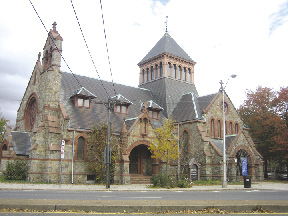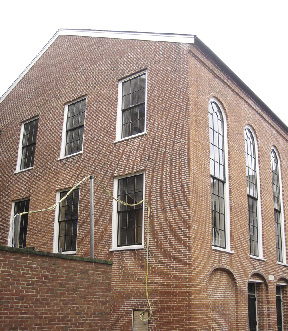Architecture often defines a city. From modest brownstone structures to soaring skyscrapers, architecture covers a broad scope of engineering and design elements.
Boston is one of the oldest cities in America. Since its founding in 1630, Boston has always been a melting pot of old traditions and new ideas. In the late 19th century, the city came into its own as a cultural and architectural center. During this flourishing era, Massachusetts College of Art, the nation's first and only publicly funded art school, and the Museum of Fine Arts, one of the finest museums in the world, were founded. In addition, two of Boston's grandest buildings, H.R. Richardson's masterpiece Trinity Church, and the Boston Public Library, by McKim Mead and White, were designed and built. Many of the most significant American architects have strong Boston ties, including Charles Bulfinch, Frank Lloyd Wright, Frederick Law Olmsted, and I.M. Pei.
Boston's rich architectural landscape is marked by diversity and an astonishing juxtaposition of styles, periods, and purposes. The Trinity Church stands across the street from the magnificent Hancock Tower; the Old State House at the summit of Beacon Hill, looks down on today's modern state office buildings; and the magnificent new City Hall is separated from Faneuil Hall only by Sam Adams' statue. Yet, despite this diversity, there are entire sections of the city where historic and architectural cohesion is clearly evident.
Most of Boston's commercial buildings in the late 1800s were constructed of brick, copper, or stone, or a combination of these materials. Considering the extreme elements, the vast majority of these structures have held up quite well with routine maintenance over time. However, "maintenance" of such historical buildings is more appropriately termed "restoration" to preserve their architectural integrity.
St. James Episcopal Church
St. James Episcopal Church is a historically significant brownstone structure built on Mass. Ave. in Cambridge in 1888. The building is designed in a Richardsonian Romanesque architectural style popular in that era. Over the years, the sanctuary has come to house many beautiful stained glass windows and a historic bell re-cast by Paul Revere.
In 2007, an architectural firm (Davies & Bibbons, Cambridge, MA) was contracted to inspect the bell tower located at the north side of the building, and determined that mortar holding the stones had severely deteriorated over time causing the stones to dislodge.
Abbot Building Restoration was contracted to remove the entire bell tower down to the roofline, and rebuild the tower under the direction of the Massachusetts Historical Society. In order to preserve the historical integrity of the building, Abbot carefully removed and numbered each and every stone, applied new mortar, and replaced the stones in the exact order as they were removed.
African Meeting House
The African Meeting House is a National Historic Landmark located in Boston's Beacon Hill neighborhood that was once the heart of Boston's 19th Century African-American community. Built in 1806, the African Meeting House is the oldest known existing black church in the United States, and was a place of discussion for many of the nation's most prominent abolitionists, such as Frederick Douglass, William Lloyd Garrison, and Charles Sumner. The building was part of Boston's Underground Railroad Stations that sheltered many fugitive black slaves prior to the Civil War. Owned and operated by the Museum of Afro American History, the African Meeting House is now a part of the National Park Service. The facade of the building is an adaptation of a townhouse design by Boston architect Asher Benjamin.
In 2000, Abbot was contracted to perform masonry repairs including repointing of joints, infilling of brick voids, and replacement of spalled brick on three sides of the building. Significantly, under the direction of the National Park Service, Abbot was able to salvage matching brick from a building demolition in the Beacon Hill area to maintain the historical integrity of the structure. Abbot also resourced special mortar compounds to match the color and composition as required by the National Park Service to meet historical guidelines.
A Cooperative Effort
A key to a successful historic restoration is often the cooperation among the architectural/engineering consulting firm, the regulatory agency, and the masonry contractor. The consultant evaluates the condition of the building, defines the problems, conducts appropriate tests, and provides a bid specification for the project. The regulatory agency assures that the historical integrity of the building is maintained during the restoration. The contractor provides the expert workmanship for the project in conjunction with the engineering design specifications and regulatory supervision.
Tags:
Abbot Restoration: Maintaining the historical integrity of Boston's architectural landscape
May 04, 2010 - Owners Developers & Managers
 (1).png)









